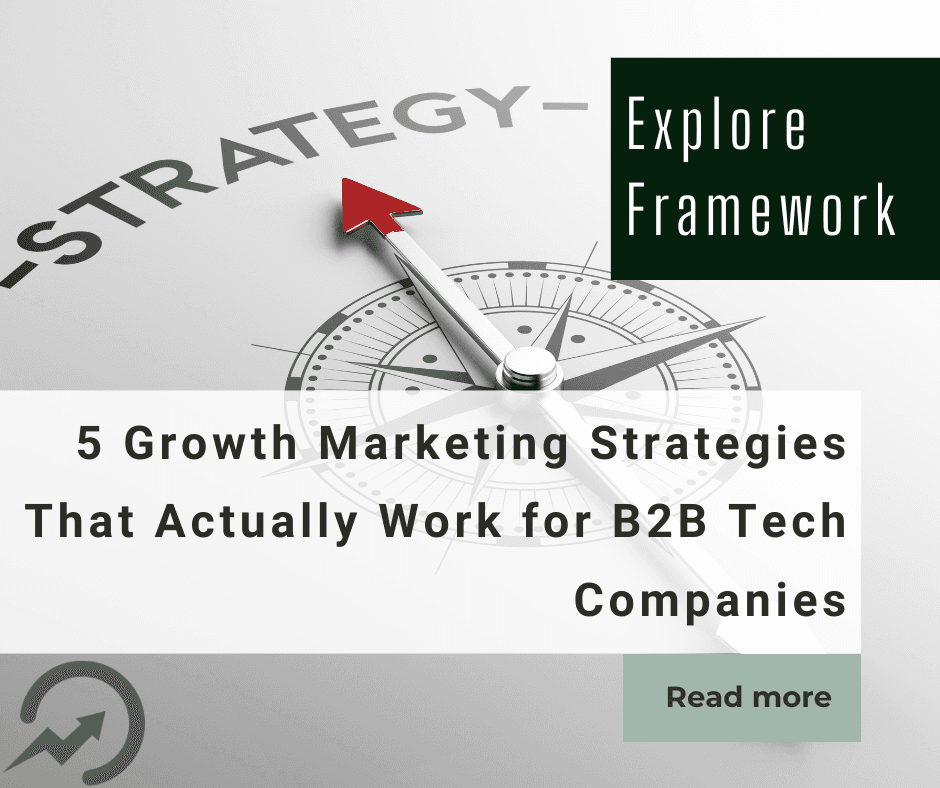
~ by Arwa Bombaywala |
10/22/2025
If you're leading marketing at a mid-sized B2B tech company, you know the challenge: you're past the scrappy startup phase, but you don't have the enterprise budget to spray and pray. Every dollar counts, every campaign needs to justify itself, and your board wants to see pipeline growth yesterday.
The good news? You don't need a massive team or unlimited resources to build a high-performing growth marketing engine. You need focus, smart execution, and strategies that actually move the needle. Here are five approaches we're seeing work consistently for companies at your stage.
You already know this, but it's worth repeating: not all leads are created equal. The fastest way to waste your growth marketing budget is chasing accounts that will never convert or customers that churn in six months.
Take a hard look at your best customers: the ones who buy quickly, stay long-term, and refer others. What do they have in common? What problems were they actively trying to solve when they found you? Now build your entire demand generation strategy around finding more companies that look exactly like them.
This means going beyond basic firmographics. Layer in intent signals: which companies are researching solutions like yours right now? Which ones just raised funding or hired a new leader in your target department? When you focus on accounts showing real buying signals, your conversion rates improve dramatically and your sales team actually wants to follow up on your leads.
Here's the reality: you can't manually personalize everything for every prospect. But you also can't just blast generic emails and hope for the best.
The answer is finding the right balance. Use automation for the heavy lifting: lead scoring, email sequences, data enrichment, campaign triggers. But when it comes to the moments that actually build relationships, make it personal.
That might look like your AE sending a quick video to a high-value prospect referencing their recent company announcement. Or your founder engaging directly with decision-makers through LinkedIn marketing tactics. Or customizing your demo deck to show examples from their specific industry.
The key is being strategic about where you invest the human touch. Save it for high-intent accounts, key decision-makers, and critical moments in the buyer journey. Your team will thank you, and your prospects will actually respond.
There's endless pressure to be everywhere: LinkedIn, paid search, SEO, events, webinars, podcasts, TikTok (maybe?). But here's the truth: you don't have the bandwidth to do everything well.
Instead, double down on the channels where your buyers actually spend time and where you're seeing real ROI. For most mid-market B2B tech companies, that's usually a core set: LinkedIn for reaching decision-makers, SEO for capturing in-market search demand, and targeted events or webinars for deeper engagement.
A solid LinkedIn marketing strategy should be at the heart of your growth marketing approach. LinkedIn marketing works because that's where your buyers are researching solutions, following thought leaders, and making connections that influence purchasing decisions.
Create strong foundational content: comprehensive guides, case studies, product comparisons. Then atomize it. Turn that whitepaper into a webinar, pull quotes for social posts, create a video series, break out data for infographics. You get more mileage from less content creation, and you reinforce your message across multiple touchpoints.
The goal isn't omnipresence. It's showing up consistently where it counts, with content that actually helps your buyers make better decisions.
You've heard this one before, but let's be honest: how aligned are your teams really? Do they share the same goals? Do they actually talk regularly? Does sales give you feedback on lead quality, or do MQLs just disappear into a black hole?
Real alignment means shared pipeline targets, regular sync meetings, and honest conversations about what's working and what's not. It means marketing creating assets that sales actually uses: battlecards, ROI calculators, objection handlers, industry-specific one-pagers.
It also means sales giving marketing real feedback: which content resonates in conversations? What objections keep coming up? Which competitors are they seeing most often? This intelligence loop makes your growth marketing smarter and your sales team more effective.
When you fix this relationship, everything else gets easier. Campaigns convert better. Deals close faster. Everyone stops pointing fingers and starts hitting goals together.
At your stage, you can't afford to keep running campaigns just because "we've always done it that way." Everything should be an experiment with clear success metrics.
Run A/B tests on your landing pages. Try different email subject lines. Test messaging angles. Experiment with ad creative and LinkedIn marketing campaigns. Track what content actually drives pipeline, not just downloads.
The key is creating a culture where it's safe to try new things and okay to kill what's not working. Look at your funnel data weekly. Where are people dropping off? Which campaigns are generating SQLs versus time-wasters? What's your actual cost per closed deal by channel?
The companies that win aren't the ones with perfect strategies out of the gate. They're the ones that learn faster and adapt quicker than their competition.
You don't need a revolutionary approach to grow your pipeline. You need to execute the fundamentals exceptionally well: know exactly who you're targeting, automate intelligently while staying human, focus your resources on what works, align your go-to-market teams, and constantly optimize based on real data.
The companies winning in mid-market B2B tech aren't outspending everyone. They're outthinking them with smart growth marketing strategies that compound over time.
Ready to audit your current approach? Take 30 minutes to map your funnel, identify your biggest bottleneck, and pick one thing to test this month. Or if you want an outside perspective, the VORD team specializes in helping mid-market tech companies build growth marketing engines that actually scale. Let's talk about what's possible for your business.
Discover how our integrated approach can deliver predictable growth in engagement, authority, and revenue for your business.